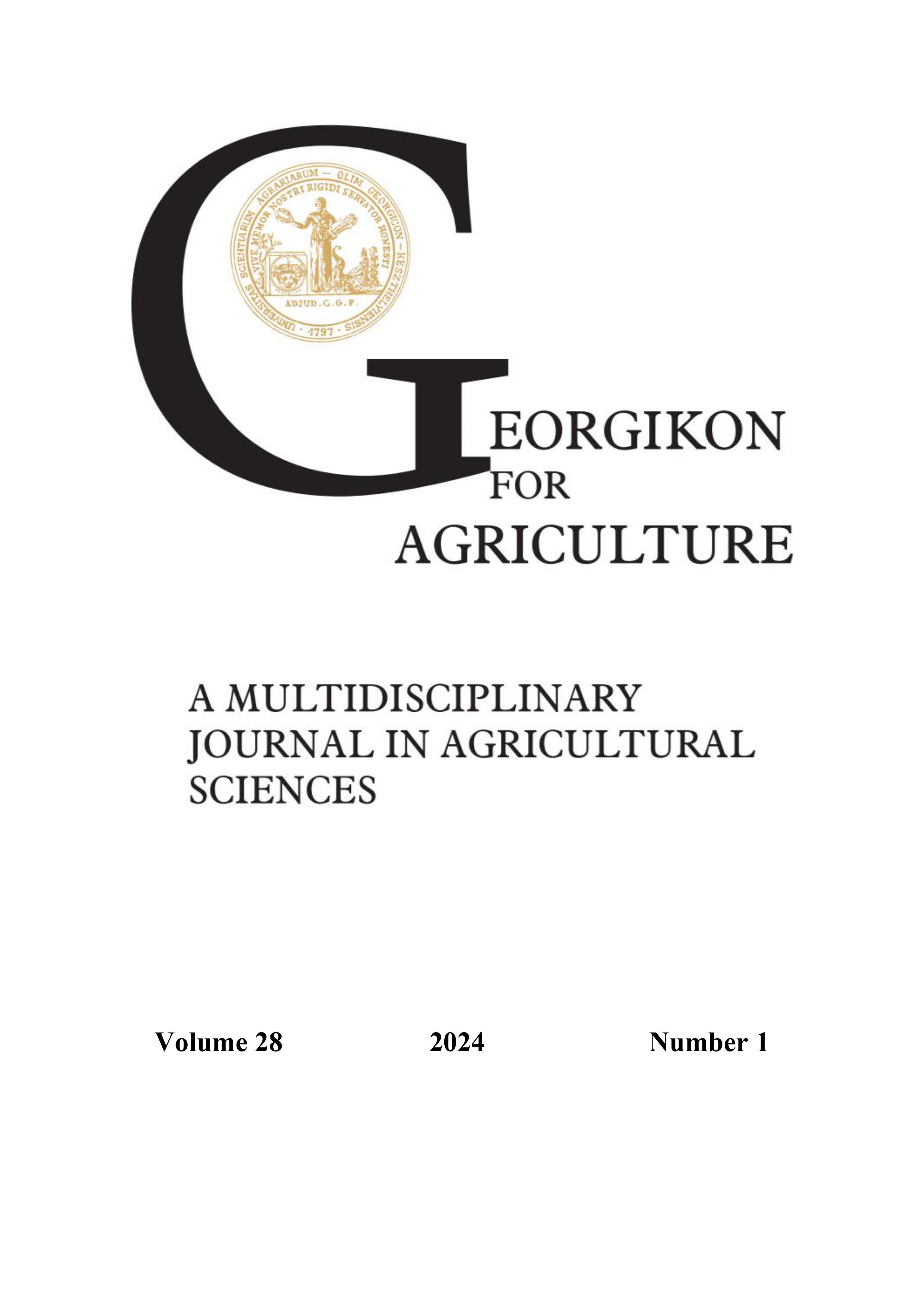Effect of precipitation on wheat (Triticum aestivum), maize (Zea mays), and sunflower (Helianthus annuus) yields in the district of Szentes
DOI:
https://doi.org/10.70809/6552Keywords:
Triticum aestivum, Zea mays, Helianthus annuus, rainfall extremities, drought, Great Hungarian PlainAbstract
Hungary's three most important arable crops are wheat, maize, and sunflower. These crops have the largest area under cultivation. In our study, we compared the average yields of a 200-ha farm on the outskirts of Szentes city with variations in rainfall conditions. We have shown that the amount of rainfall during the growing season affected the yield averages of wheat and maize and their prices on the world market. Yields of drought-sensitive maize, which prefers humid conditions, were most dependent on rainfall. However, rainfall also proved to be a significant factor in wheat yield averages. Sunflower yield averages did not correlate with rainfall, which may be because water demand is highly dependent on the phenological stage. Therefore, a good rainfall distribution over time is also important for this crop. Changes in rainfall patterns due to climate change do not favor any crop. This is because climate change is reflected in a linear trend in annual rainfall amounts and greater rainfall variability over time and space.
References
Alaei, M., Zaefizadeh, M., Khayatnezhad, M., and Alaei, Z. 2010. Evaluation of Germination Properties of Different Durum Wheat Genotypes under Osmotic Stress. Middle-East Journal of Scientific Research. 6 (6) 642‒646.
ATIVIZIG, Lower Tisza Region Water Directorate, 2024. Szentes csapadékadatok napai, havi és éves bontásban. (in Hungarian)
Hetesi, Zs., Szám, D., Lakatos, B., Belényesi, M., Birinyi, E., Mikus, G., and Kristóf, D. 2023. A 2022-es aszály éghajlati, tájhasználati okai és következményei. Agrofórum – A Növénytermesztők és Növényvédők Havilapja. 34 (2) 18–22. (in Hungarian)
Jánosi, A., Fekete, Á., and Szám, D. 2023. Markov-láncok alkalmazása az aszályos napok valószínűségének megállapítására Budapest térségében. Hadmérnök. 18 (3) 69–81. https://doi.org/10.32567/hm.2023.3.6 (in Hungarian)
KSH, Hungarian Hungarian Central Statistical Office, 2020. 19.1.2.1. Földterület művelési ágak, valamint vármegye és régió szerint [ezer hektár]. (in Hungarian) https://www.ksh.hu/stadat_files/mez/hu/mez0068.html
KSH, Hungarian Hungarian Central Statistical Office, 2022. A fontosabb növények vetésterülete. (in Hungarian) https://www.ksh.hu/s/kiadvanyok/a-fontosabb-novenyek-vetesterulete-2022-junius-1/
KSH, Hungarian Hungarian Central Statistical Office, 2024. 1.1.1.13. Gabonafélék felvásárlási átlagára [Ft/tonne]. (in Hungarian) https://www.ksh.hu/stadat_files/ara/hu/ara0013.html
Lacolla, G., Caranfa, D., Corato, U. D., Cucci, G., Mastro, M. A., and Stellacci, A. M. 2023. Maize Yield Response, Root Distribution, and Soil Desiccation Crack Features as Affected by Row Spacing. Plants. 12 (6) 1380. https://doi.org/10.3390/plants12061380
Márton, L., Lehoczky, É., and Wágner, G. 2013. Study on the weeds of maize in the infected field with Cirsium Arvense (l.l) scop. Acta Agraria Debreceniensis. 51 131‒135. https://www.doi.org/10.34101/actaagrar/51/2077
Nouri, A., Etminan, A., Silva, J. A., and Mohammadi, R. 2011. Assessment of yield, yield-related traits, and drought tolerance of durum wheat genotypes (Triticum turgidum var. Durum Desf.). Australian Journal of Crop Science. 5 (1) 8‒16.
Nyiri, L. 1993. Földműveléstan. Mezőgazda Kiadó, Budapest, 47‒85. (in Hungarian)
Pál-Fám, F. and Rudolf, K. 2014. Gombakórokozók a kukoricán és előfordulásuk csapadékos években. Agrofórum Extra. 57 84‒87. (in Hungarian)
Ragheid, A., Tahar, B., and Abdellah, A. 2011. An intelligent irrigation system for wheat in Saudi Arabia uses wireless sensors and network technology. International Journal of Water Resources and Arid Environments. 1 (6) 478‒482.
Stott, P. A., Christidis, N., Otto, F. E. L., Sun, Y., Vanderlinden, J-P., Jan van Oldenborgh, G., Vautard, R., Storch, H., Walton, P., Pascal, Y. W., and Zwiers, F. 2016. Attribution of extreme weather and climate-related events. WIREs Climate Change. 7 23–41. https://doi.org/10.1002/wcc.380
Tamás, A., Radócz, L., Horváth, É., and Zagyi, P. 2022. A termesztéstechnológiai tényezők hatása a kukorica (Zea mays L.) terméseredményeire polifaktoriális tartamkísérletben. Növénytermelés. 71 67‒80. (in Hungarian)
Varga, P., Béres, I., and Reisinger, P. 2002: Három veszélyes gyomnövény hatása a kukorica termésalakulására három eltérő csapadékellátottságú évben. In: XII. Keszthelyi Növényvédelmi Fórum p. 42. (in Hungarian)
Varga-Haszonits, Z. and Varga, Z. 2005. Nyugat-Magyarország éghajlati viszonyai és a kukorica. p: 71‒79. In Csete L. (ed) Agro-21 Füzetek, Klímaváltozás ‒ Hatások ‒ Válaszok. AGRO-21 Kutatási Programiroda, Budapest, 43. (in Hungarian)
Wójcik-Gront, E. and Gozdowski, D. 2023. Effect of Climate Change in Years 2006‒2019 on Crop Yields in Poland. European Journal of Sustainable Development. 12 (4) 225‒236. https:www.doi.org/10.14207/ejsd.2023.v12n4p225
Xuemei, J. I., Jianlin, W., David, C. L., Colin, L. D. J., Anthony, G. C., Richard A. R., and Rudy, D. 2010. Importance of pre-anthesis and sink strength for maintenance of grain number during reproductive stage water stress in wheat. Plant, Cell and Environment 33 (6) 926‒942. https://doi.org/10.1111/j.1365-3040.2010.02130.x
Downloads
Published
Issue
Section
License
Copyright (c) 2024 Szám Dorottya, Keve Gábor, Koch Dániel, Hetesi Zsolt

This work is licensed under a Creative Commons Attribution-NonCommercial-NoDerivatives 4.0 International License.
Cikkre a Creative Commons 4.0 standard licenc alábbi típusa vonatkozik: CC-BY-NC-ND-4.0. Ennek értelmében a mű szabadon másolható, terjeszthető, bemutatható és előadható, azonban nem használható fel kereskedelmi célokra (NC), továbbá nem módosítható és nem készíthető belőle átdolgozás, származékos mű (ND). A licenc alapján a szerző vagy a jogosult által meghatározott módon fel kell tüntetni a szerző nevét és a szerzői mű címét (BY).




